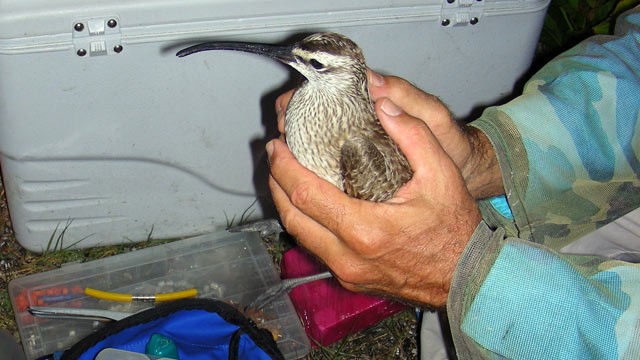Fletcher Smith, a research biologist at the College of William and Mary's Center for Conservation Biology in Williamsburg, Va., said that he and a team of scientists had been tracking Chinquapin -- a shorebird that breeds in the high Arctic and spends its winters in Brazil -- since the spring of 2010 to learn more about its migratory routes.
Last week, the bird -- outfitted with a satellite transmitter backpack that allowed those at the center to note his movements -- flew right through Irene and then disappeared from the monitors as scientists watched helplessly.
Georgia Department of Natural Resources
This whimbrel named Chinquapin is reportedly... View Full Size
"We were all walking around on pins and needles hoping that the bird made it through," Smith told ABC News today. "We had to wait a full 48 hours before the next set of data points came in."
Thankfully Friday, they got a single signal from the bird. He was apparently alive and well -- and in the Bahamas.
Birds Travel Up to 3,500 Miles
Chinquapin left Canada's Upper Hudson Bay on Aug. 22. Chinquapin was flying over the Atlantic Ocean Wednesday when he encountered Irene, then a Category 3 storm with 110 mph winds.
Whimbrels stand about 1.5 feet tall and are frequent long-haul fliers. They can travel up to 3,500 miles without rest and at speeds of up to 50 mph. Smith said that whimbrels were almost double their weight before they migrated.
"The whimbrel is able to survive the hurricane because of the tremendous fat stores that they're able to put on," Smith said. "They're able to expend the amount of energy that it takes to fly through the hurricane."
He said that scientists still did not know how Chinquapin managed to stay in the air and not be tossed off course or killed as had happened to other migratory birds in severe storms.
Chinquapin flew around Tropical Storm Colin in 2010 while a second bird flew into the storm and died, according to center director Bryan Watts.
"There are probably very few birds that could actually fly right through the eye of the hurricane and make it to landfall," Smith said. "You can only speculate that it must have been exerting a lot of energy to get through the hurricane eye."

No hay comentarios:
Publicar un comentario